When SpaceClaim was first released it was clear it had the potential to become the next big thing in 3D design. The company’s founders had an enviable track record of success and the product offered something, if not unique, certainly well packaged and different from the mainstream. Yes, it followed the non-history, direct modelling approach found in the likes of CoCreate and IronCAD, but the really interesting thing was the user experience. SpaceClaim was ultra-dynamic. Users interacted directly with the geometry, and only re-coursed to toolbars and icons rarely. That was something of a shift.
In the intervening years the product has started to find a niche. From talking to its customers it’s clear there’s an emerging interest from two sets of users in particular. Firstly, those that have a lot to offer the design process in terms of ideas, but have historically had no real interest in traditional CAD. Secondly those involved in simulation. Both sets of users typically have a lot of technical knowledge in their chosen area, but learning a mainstream 3D CAD system is not a priority, particularly as some of these systems are prohibitively expensive for ‘occasional’ CAD users.
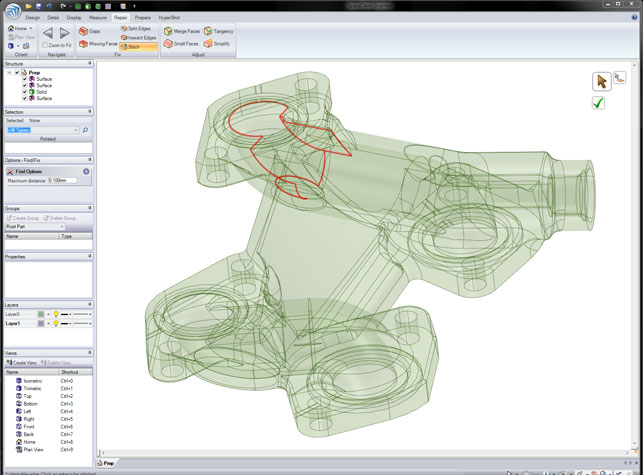
This imported model demonstrates some surfaces that didn’t initially knit together into a solid. SpaceClaim’s Repair tools identify problem areas, which can be fixed individually or automatically
Modelling updates
For the 2009+ release there are three key updates to SpaceClaim’s core modelling capabilities.
The first enables bodies to be locked in order to prevent unintentional changes being made to their form. With SpaceClaim, users don’t need to have an intimate knowledge of how the model is constructed as they would with a history-based system. While that’s incredibly powerful, it also means geometry can be changed without the user realising it – particularly when using the power selection panel. This new capability allows specific bodies to be locked (remember, SpaceClaim allows multiple bodies within a single part), meaning that working envelopes and interface features can be locked and remain consistent.
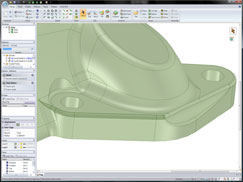
Not all rounds, such as this selected chain, are easily removed in one operation. In these cases, SpaceClaim provides the ability to subdivide round chains
The second update is that curves created on faces can be more easily manipulated, whereas in previous versions it was often a case of ‘touch it and miss’. This means that users can quickly sketch out feature shapes using curves, directly on a face, then more easily refine and manipulate those curves as required.
The third update is regarding round creation and editing. One of the major problems with direct modelling techniques, irrespective of the vendor, surrounds the manipulation of anything other than simple rounds and fillets. In many choreographed direct modelling demos, fillets are usually uniform in radius, but these idealised cases, which are required for a clean edit, don’t often happen in the real world. To overcome this, SpaceClaim now includes a dedicated round slicing tool that allows the user to work through fillet chains and remove them one by one, section by section, so the system has a chance to rebuild the sharp edges required. Then, if needs be, the more powerful rounding tools can be used to add back in the new fillets where required.
There have been a number of other updates across the system’s range of capability (such as in surfacing, pattern creation and the use of construction geometry), but these are the key updates.
Modelling for Simulation
For the last year or so, SpaceClaim has been working with one of the masters of simulation, Ansys, and the company recently took on SpaceClaim as the preferred modelling solution for its customers. It’s quite clear that Ansys and its customers are having a great deal of influence on the direction of SpaceClaim, and many of the updates in the 2009+ release target the simulation user. In specifics, there is a concentration on making the de-featuring or abstraction of geometry both easier and more powerful, particularly when dealing with complex geometric conditions.
SpaceClaim includes a dedicated round slicing tool that allows the user to work through fillet chains and remove them one by one, section by section
The new release also sees the beginning of greater integration between SpaceClaim and Ansys Workbench, manifesting itself with tools that support beam-based simulation tasks. Those involved in simulation will already know that using beam elements dramatically reduces the calculation time for simulation runs, as each element has knowledge of its own structure and beam properties (moment of inertia etc). When used alongside Workbench, SpaceClaim allows users to create a beam suitable model (whether that’s framework for machinery, structural steel doesn’t really matter). The system has a library of standard sections but custom sections can also be added.
Once the 3D design has been developed, users can then extract the beams from the geometry, create the theoretical model and transfer it to workbench for simulation. The link is maintained, so geometry modifications can be made within SpaceClaim and quick moved through the simulation process for validation.
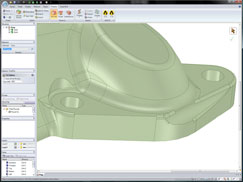
SpaceClaim’s Round Removal tool can remove individual rounds or split rounds into separate pieces by removing the centre
Multi-touch
The final section in this review is something rather unique and that is multi touch. A few months back on develop3d.com we posted a rather impressive video demo that the SpaceClaim team had put together. Now with the release of 2009+ we are seeing the first shipment of those tools. SpaceClaim has taken its already intuitive user interface and added in support for multi-touch, allowing users to directly model and manipulate both the view and the geometry, using their fingers rather than the mouse and keyboard.
The basics are covered with multi-touch view rotation, panning and zooming, but also selection tools (such as the four-finger box and lasso) and gesture support. The existing graphical feedback within SpaceClaim lends itself to direct input.
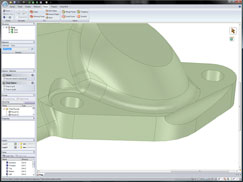
After subdivision, the remaining small rounds are easily removed
Multi-touch devices are at a very formative stage of development and commercialisation and outside of the iPod Touch and iPhone, there is little that is commercially available. However, from speaking to the major hardware vendors, it’s clear that this will change in the coming months, particularly as the multi-touch enabled Windows 7 starts to proliferate. However, for the time being it’s unlikely that many SpaceClaim users will make use of its capabilities.
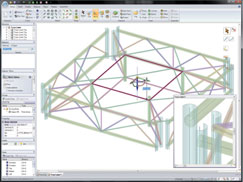
Click here to see an example of SpaceClaim to Ansys Workflow
Conclusion
For the past few years SpaceClaim has been finding its feet and is now starting to carve itself a real niche. From the ourset its developers identified that there is a class of 3D user out there that doesn’t want to learn one of the all-encompassing mainstream modelling tools. These users want something to let them capture their ideas and move them on into other areas such as manufacturing or simulation. The link to Ansys Workbench is a perfect example of this and a strong recommendation from one of the simulation sector’s leading players.
All in all, SpaceClaim 2009+ is another solid release and one that sees one of the newest 3D modelling systems on the block advance with a range of modelling updates, while still managing to keep things simple.
https://www.develop3d.com/images/lightbox_images/Spaceclaim-Workflow-LB.jpg
| Product | SpaceClaim 2009+ |
|---|---|
| Company name | SpaceClaim |
| Price | SpaceClaimfrom £1,865 |






